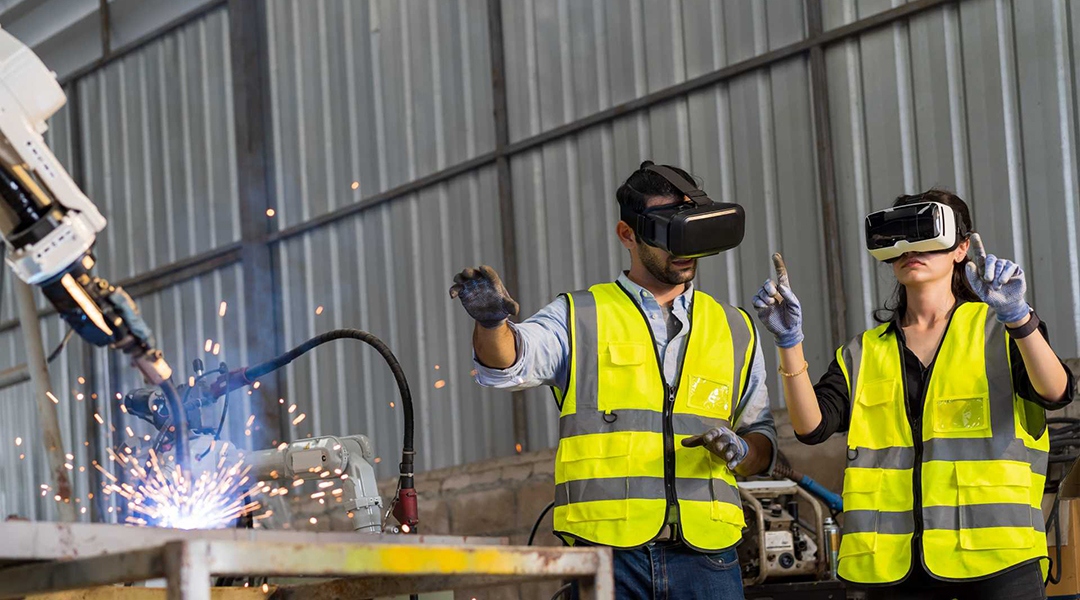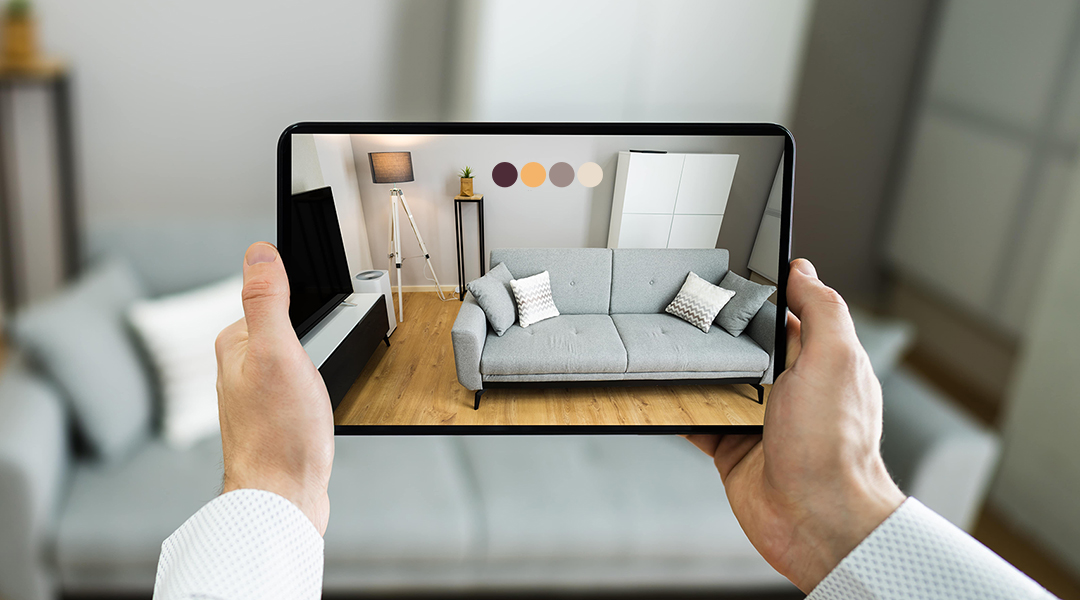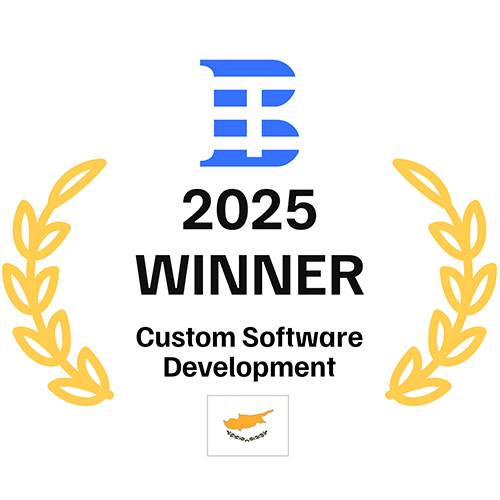As we become more and more used to doing things remotely, eCommerce is thriving. Consumers have embraced online shopping, and it currently accounts for about 18% of all retail sales. With these numbers, creating a fulfilling shopping experience online should be a top priority for retail providers, and virtual reality is one of the greatest tools they have in accomplishing it.
How does virtual reality in retail work?
Virtual reality in retail delivers simulations to shoppers and retail workers through special hardware (headsets) and software (3D applications). Because of the nature of the industry, these simulations tend to focus on the products of the company or other business processes. While headsets can be easily purchased online, the software is usually built by a professional VR app development company.
In this article, we will examine the potential of VR in retail and how it might help your business if you choose to implement it. We can also help you get started with your own virtual reality shopping app.
4 Groovy Use Cases of Virtual Reality in Retail (The Customer’s Experience)
Customer-focused VR experiences have come a long way since the early days of the technology, when it was just seen as something new and flashy. Today, virtual reality in retail brings tangible benefits to shoppers:
-
A virtual shopping mall
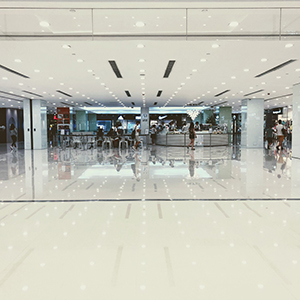
As you might guess, this case of virtual reality in retail is a simulation of a store or chain of stores in a single location. Thus, users can put on their headsets anywhere and walk through the stores, discovering great brands without the need to drive or do any physical work. This immersive experience not only saves time and energy but also allows customers to explore products in a detailed and interactive environment, enhancing their shopping experience.
One recent example of such a mall is a 3D virtual shopping center called VI Mall. The solution features multiple department stores based in Malaysia and even a virtual cinema. You might not be able to try on many clothes with this app, but you can quickly find the stores that most interest you.
-
Product configurator
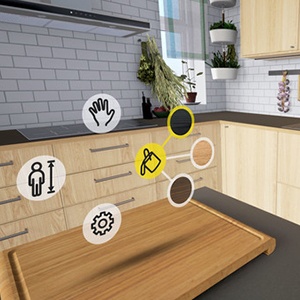
Some retailers go all out in accommodating clients’ desires, and this includes personalizing their products. A 3D product configurator, a testament to the capabilities of VR in retail, lets shoppers select the build of their product, making choices about its design and functionality through various interactive options in the app. This example of virtual reality in retail also usually features a 3D model of the product that updates in sync with the customization changes.
IKEA, the well-known furniture giant, offers a kitchen configurator accessible on HTC Vive headsets. In the app, users can try out dozens of customization options for their kitchen layout before placing an order. This case also shows a key benefit to be gained from virtual reality interior design.
-
Virtual store tour
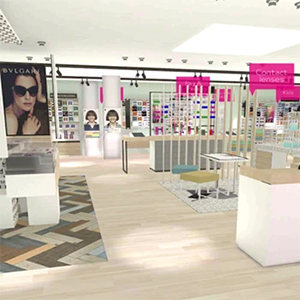
This example of virtual reality in retail is focused on a single store and its products. Usually, it recreates or mimics the actual store design and features the products that are sold at the brick-and-mortar equivalent. This tour can be guided by a personal assistant or leave visitors free to explore and look at everything at their own pace and with no pressure. Additionally, it offers the unique advantage of providing detailed information and virtual trials for products.
Our company created such an application for Magrabi, an eyewear company based in Dubai. It is meant to be used with Google Cardboard - one of the best VR headsets in terms of price and accessibility. The app features a highly realistic 3D representation of an actual Magrabi store, complete with up-to-date inventory and triggers that activate when a user approaches a stand, giving them info about the products.
-
Product simulation and preview
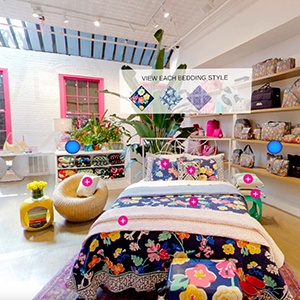
Many retailers use AR to let customers preview products, but this use case is a bit different from other examples of virtual reality in retail. Virtual reality doesn’t normally make use of an external camera, so you won’t see your surroundings with digital elements layered on top. Instead, you are fully immersed in a digital world where you can see products in much more detail and enjoy more flexibility in tinkering with them.
For example, Vera Bradley (a popular American bag company) released a virtual shopping project on Google Daydream that lets customers preview its products (beds, quilts, etc.) in a simulated environment. Interestingly, the company did not rely on customers having their headsets and instead delivered the hardware to 10 stores for in-person testing.
What About Retail Businesses? Does VR Help Them Too?
If you choose to build an app for your store/website, you don’t necessarily need to keep the virtual shopping experience focused on the customer. Below are a few other ways how virtual reality in retail can help you achieve internal business goals:
Grocery store VR aids employee training
Though you won’t be able to get VR headsets into the hands of all your customers, this is much more feasible for employees. In this case, immersive training is one of the best things you can do with the hardware. Your grocery employees will be able to pick up professional knowledge and skills at any time through simulation, and you won’t waste any time/resources on actual trainers. Walmart made great use of this approach by equipping cashiers, managers, and other associates with Oculus Go headsets running a custom application that helped them strengthen their skills.
A buzz-worthy marketing tool
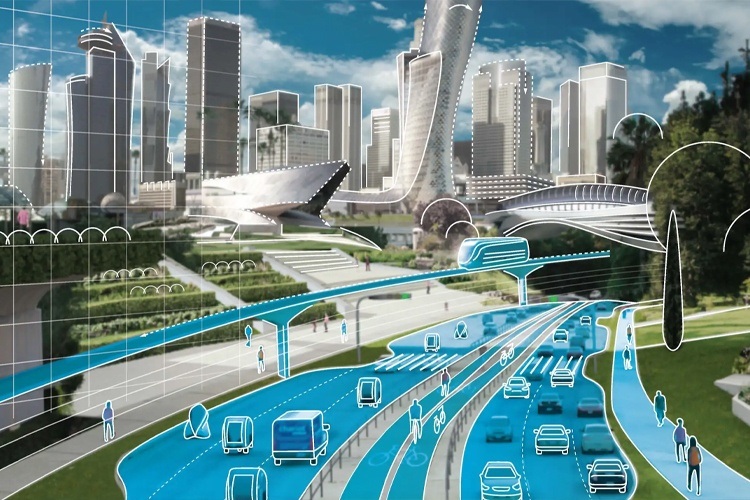
Immersive tech is a hot topic in society, so even a minimal VR experience featuring your product is sure to generate plenty of interest, buzz, and brand awareness. The Ford Motor Company would probably agree with this statement, as their “City of Tomorrow” VR experience made a splash at an auto show in Detroit, generating headlines. This is a flashy example of virtual reality in retail where the user flies above the city and gets to see many transportation products built by the company in a casual setting.
Virtual showroom
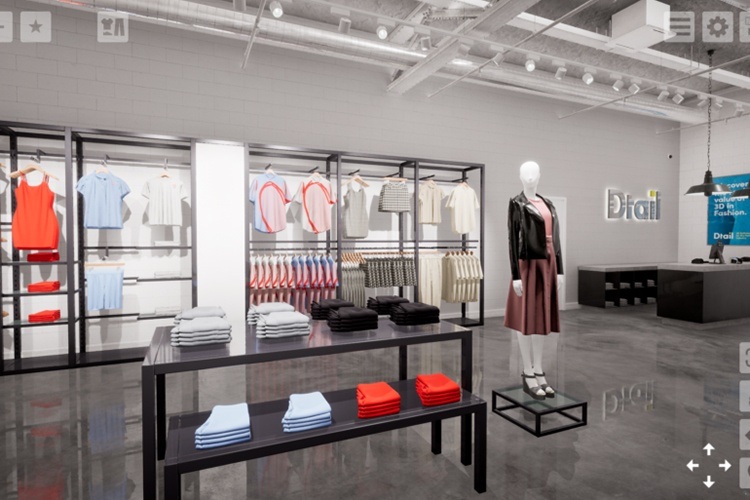
Some companies believe that a good product sells itself, but they forget the pesky need to make it seen in the first place. VR showrooms are very handy in this regard since they let people see your inventory up close and in the best light without asking them to visit any show or physical store. Asics (the famous shoemaker) tried this approach with their launch of 3 “Meta” shoe models. Their shoe fashion virtual showroom is accessible on some VR devices, as well as in the format of 360-degree video.
Virtual reality clothes shopping
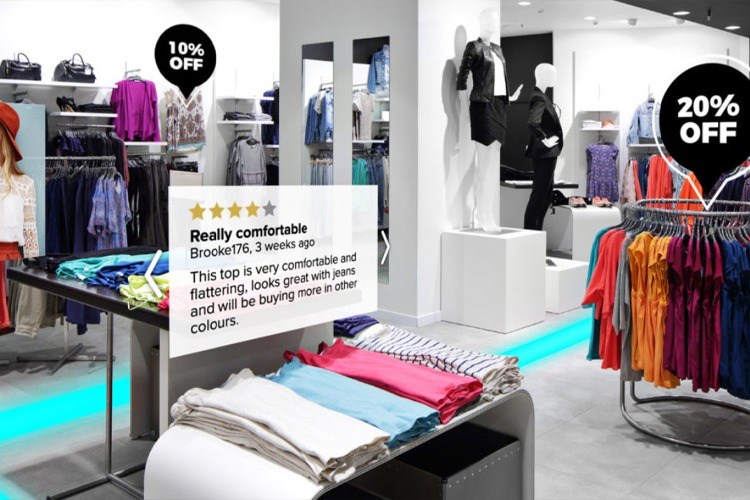
Sometimes, VR in retail is used as a replacement for boring product pages on a website. In other words, customers have their first interaction with an item virtually, and it impresses them so much that they proceed to order the item from the website/by phone/etc. For instance, Kilkenny Design (an Irish retailer) adapted its catalog to VR (Google Cardboard) in response to a surge of new online shoppers.
Virtual Store vs Online Shopping: Which is Better?
Some retail companies are hesitant to invest in immersive solutions because they have already devoted loads of resources to their websites and platforms, and believe that many of the potential uses of VR in retail can also be achieved through their web offerings. Indeed, there is some overlap between the platforms’ potential, but big differences as well. Let’s compare the traditional digital experience and integration of virtual reality in retail:
| VR Store | Web store |
| Benefits of virtual reality in retail:
Limitations of virtual reality in retail
| Benefits of a web store:
Web store limitations:
|
| Conclusion Web stores are a good place to tell about your product and sell it, while VR stores are great for showing it off and letting people feel it (almost). Virtual reality in retail also provides unique avenues for improving brand awareness and making business processes (like training) more effective. | |
VR Shopping Assistants: Reliable Aid in Customer Shopping Activities
Have you ever imagined a shopping experience where a virtual guide knows exactly what you're looking for, offers personalized recommendations, and helps you make informed decisions without stepping out of your house? Welcome to the world of VR shopping assistants. These digital guides are powered by VR technology, designed to transform your retail experience into something more personalized, interactive, and convenient.
So, how do these virtual assistants work? They are programmed to understand your shopping preferences and history, using this information to tailor product suggestions and shopping experiences that resonate with your tastes. From virtually trying on clothes to testing out how a new sofa might look in your living room, these assistants make use of virtual reality in retail to bring products to life in ways traditional online shopping can't.
Diverse Use Cases: A New Dimension to Every Shopping Scenario
- Fashion and Apparel: Imagine trying on outfits in a virtual dressing room, where you can mix and match clothing without physically changing.
- Furniture and Home Decor: Place virtual furniture in your home to see how it fits and looks before making a purchase.
- Electronics: Get a 360-degree view of gadgets, with the ability to interact with them, and understand their features in-depth.
- Grocery Shopping: Walk through virtual aisles, pick products, and learn about their nutritional value and origin.
The Benefits of Leveraging VR Shopping Assistants
- Enhanced Customer Experience. By providing interactive and immersive shopping experiences, VR assistants make shopping more engaging and enjoyable.
- Personalized Recommendations. They understand individual preferences and suggest products accordingly, making shopping more efficient.
- Informed Decision-Making. With detailed product demonstrations and information, they help customers make better-informed decisions.
- Accessibility and Convenience. Shopping becomes more accessible, especially for those who can't easily visit physical stores.
- Reduced Return Rates. By enabling customers to better understand products before purchasing, VR assistants can significantly reduce return rates.
- Increased Sales and Customer Loyalty. Personalized and enjoyable shopping experiences lead to increased sales and customer loyalty.
VR shopping assistants represent a significant stride in the evolution of virtual reality in retail. They offer a futuristic shopping experience and address many limitations of online and in-person shopping. As we move forward, these virtual assistants are poised to become an indispensable part of the retail world, making shopping more personalized, informed, and enjoyable for everyone.
Benefits of Virtual Reality in Retail
Imagine a world where trying on a dress, testing a gadget, or walking through a new kitchen no longer requires physical presence in a store. This is no longer a fragment of imagination, but a reality made possible by virtual reality in retail. The leap from traditional window shopping to immersive virtual realities marks a significant evolution in how we experience and interact with products. Let's delve into seven key benefits of integrating virtual reality in retail:
The Benefit of VR in Retail #1: Immersive Product Demonstrations
VR in retail enables customers to experience products in a 3D environment. This is particularly beneficial for items like furniture or vehicles, where spatial understanding is crucial.
The Benefit of VR in Retail #2: Enhanced Customer Engagement
By providing an immersive and interactive shopping experience, VR in retail captures the attention and interest of customers more effectively than traditional methods.
The Benefit of VR in Retail #3: Personalized Shopping Experiences
Virtual reality in retail can tailor the shopping experience to individual preferences, suggesting products based on past behavior and preferences.
The Benefit of VR in Retail #4: Reduced Return Rates
Customers get a better sense of the product before purchase with the help of VR in retail, leading to more satisfaction and fewer returns.
The Benefit of VR in Retail #5: Cost-Effective Store Layouts
Retailers can experiment with store layouts in a virtual environment, saving costs on physical rearrangements.
The Benefit of VR in Retail #6: Global Reach
Virtual reality in retail breaks geographical barriers, allowing customers from anywhere in the world to experience products as if they were in a physical store.
The Benefit of VR in Retail #7: Data-Driven Insights
Retailers can gather valuable data on customer preferences and behavior within the VR environment, leading to more informed business decisions.
The Benefit of VR in Retail #8: Sustainable Shopping Practices
VR reduces the need for physical samples and prototypes, contributing to more sustainable and environmentally friendly retail practices.
The integration of virtual reality in retail is not just a technological advancement; it's a complete reshaping of the shopping experience. It's about bringing products to life, understanding consumer needs on a deeper level, and creating an engaging, personalized shopping journey. As we embrace this future-forward approach, the possibilities of virtual reality in retail become as limitless as our imagination.
Bridging the Virtual Gap: Tackling Challenges in Virtual Reality in Retail with Innovative Solutions
Virtual reality in retail brings a wave of innovation but also presents unique challenges. How can retailers navigate these complexities to harness the full potential of VR? Let's delve deeper into each challenge of virtual reality in retail and its corresponding solution:
-
The Challenge of VR in Retail #1: High Implementation Costs
Explanation: Integrating VR technology can be expensive, considering the costs of hardware, software development, and content creation.
Solution: Retailers can adopt a gradual approach, starting with basic VR experiences and scaling up over time. Partnering with VR tech companies can also distribute costs more effectively. Exploring leasing options for hardware can further reduce upfront investments.
-
The Challenge of VR in Retail #2: Technological Complexity
Explanation: VR technology can be complex to implement and manage, requiring specialized skills and knowledge.
Solution: Investing in staff training is crucial to ensure a smooth operation. Retailers should also focus on developing user-friendly VR interfaces for customers. Collaborating with established VR technology providers can provide the necessary expertise and support.
-
The Challenge of VR in Retail #3: Customer Accessibility
Explanation: Not all customers have access to VR headsets or are familiar with VR technology.
Solution: Retailers can offer in-store VR experiences with provided headsets to bridge this gap. Online tutorials and customer support can guide first-time users, making the technology more accessible and less intimidating.
-
The Challenge of VR in Retail #4: Limited Product Interaction
Explanation: Early VR experiences may offer limited interaction with products, affecting the realism and engagement of the experience.
Solution: Investing in advanced VR features like haptic feedback and detailed 3D product models can create more interactive and lifelike experiences. Regularly updating VR content also keeps the experience fresh and engaging.
-
The Challenge of VR in Retail #5: Data Privacy Concerns
Explanation: The collection and use of customer data in VR can raise privacy concerns.
Solution: Retailers must implement strong data protection measures and maintain transparency about data usage. Regular compliance checks with privacy laws will ensure customer trust and legal adherence.
-
The Challenge of VR in Retail #6: VR Content Development
Explanation: Creating engaging and high-quality virtual reality content requires specialized skills and resources.
Solution: Employing skilled VR content creators or outsourcing to specialized agencies can ensure quality content. Regularly refreshing content maintains customer interest and relevance.
-
The Challenge of VR in Retail #7: Internet Connectivity Issues
Explanation: VR applications often require strong internet connections, which may not be available to all users.
Solution: Optimizing applications for VR in retail for lower bandwidth and providing offline modes can make VR experiences more accessible. Downloadable content can offer flexibility for users with varying internet capabilities.
By understanding and addressing these challenges with targeted solutions, retailers can effectively leverage virtual reality technology. This approach to using virtual reality in retail will not only enhance the customer experience but also position retailers at the forefront of innovation in the retail industry.
How to Make Your Own Virtual Store
If you choose VR as the platform for your next app or marketplace, keep in mind that building such a solution may not be cheap or easy.
First of all, you will need to do a lot of planning for integrating virtual reality in retail, deciding which business goals (e.g. presenting a product/training workers/demonstrating customizations/etc.) you want the application to fulfill. Obviously, during planning, you will also need to choose which platform you want the software to run on and the tech stack you will use during development.
For successful development, you will probably need to learn coding, 3D modeling, and QA if you don’t have anybody at the company doing these things already. Even with a simplified approach like Shopify VR, you’ll still work with complex APIs and 3D content. Of course, the alternative here is to hire a team that will handle the integration of VR in retail for your business.
Hire VR developers
To get all the specialists necessary quickly and from one place, you can consider Program-Ace’s services. Not only do we have a talented team of VR developers, but we also provide 3D artists, business analysts, QA engineers, and many other experts.
Magrabi VR Store - A Prominent Example of Virtual Reality in Retail
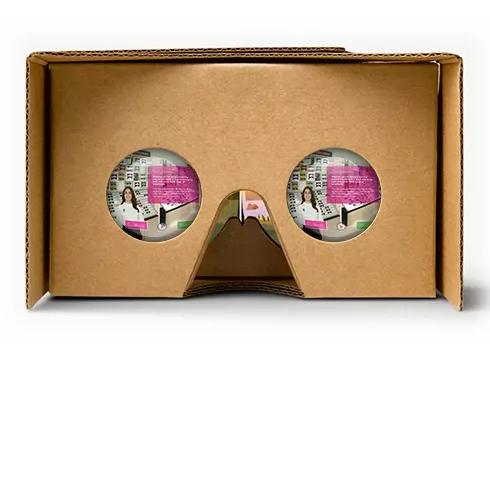
Magrabi VR store is an immersive application allowing customers to visit a real Magrabi eyewear store virtually and examine its products. This innovative solution was developed by Program-Ace and made accessible to thousands of existing and potential Magrabi customers.
We have been creating versatile VR solutions for close to a decade now, and our work in retail with brands like Magrabi, FashionTek, and PM-International has given us valuable perspectives into the needs of retail providers. You can count on us to build a custom virtual shopping platform that will help your brand and products shine!
To learn more about our capabilities in VR in retail and discuss your project, just contact us!



